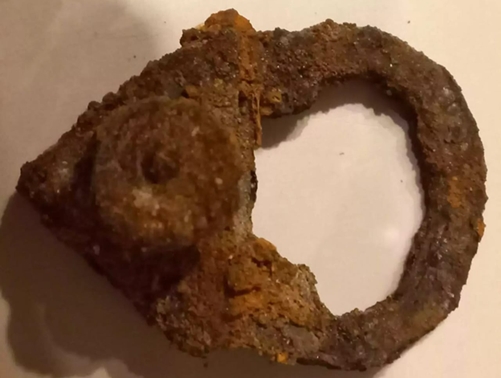
In a mesmerizing archaeological revelation that delves into the enigmatic past, researchers have
uncovered the captivating remains of a young child from the 17 th century along with a yearning in
academic’s and lay persons hearts alike as to who this child is? What did they do to be left in such a way
and to be remembered like this? . Eerily buried face down and secured to the earth with a padlock, this
discovery whispers tales of a time when society’s margins concealed souls that dared to be different.
These bones of intrigue belonged to a child, seemingly aged between 5 and 7 years, resting within an
obscure, nameless mass graveyard nestled in the Polish hamlet of Pień, near Ostromecko. This
necropolis, evoking its grim title “city of the dead” translated from Greek, also harbored the remains of
another soul — that of a “vampire” woman. She too had been interred with symbolic constraints, her
big toe affixed with a padlock, and a grim reaper’s sickle poised to sever her head should she stir from
her eternal slumber.
̎Crafting a tapestry of historical intricacies, Professor Dariusz Poliński of Nicolaus Copernicus University
— the visionary orchestrating these dual excavations — unveiled the proximity of these two eerie
graves, a mere breath away from each other. A cemetery, intended for the “excluded,” for those on the
fringes of acceptance within Christian sanctuaries, ascertains its significance.
Poliński’s diligent troupe unearthed a trove of approximately 100 interments in this unconventional
cemetery. Intriguingly, these graves showcased unconventional practices, redolent of thwarting the
return of those who would dare to defy death. The once-common “anti-vampiric” tactics played out in
the form of triangular padlocks, an intricate dance to anchor the departed to their earthly confines.
Evidence of post-burial disturbances further hints at the wariness surrounding those who might
transcend their mortal boundaries.
Deftly, Poliński offered a medley of reasons for such segregation in death. Some interred were perhaps
plagued by peculiar behavior that instilled fear among the living, or perhaps they bore the visible marks
of an ailment that set them apart. “Sudden death,” Poliński opined, “was often considered something
people should be afraid of,” giving insight into the prevailing terrors of a bygone era.
The anxieties of the seventeenth-century psyche extended even to the young ones not yet baptized or
christened, echoing a societal dread. Likewise, victims of drowning and inexplicable fatalities were
consigned to this eerie resting place, as the specter of the unknown loomed large.
More than mere skeletal revelations adorned the archaeological tableau. The hushed echoes of time
whispered through the fragments of scattered bones and the poignant remains of a pregnant woman,
cradling a six-month-old fetus within her.
Matteo Borrini, a preeminent lecturer in forensic anthropology at the esteemed Liverpool John Moore
University, shared insights last year regarding burial sites of this nature. He unveiled that these “vampire
burials” were a recurrent motif across Christian Europe, dating back to the enigmatic 14 th century.
Shadows of “vampiric” outbreaks linked to epochs of mysterious deaths, now postulated as pandemics
or large-scale poisonings, cast an eerie pall. These lost souls, dubbed “vampires,” seemed destined to
prey upon their kin, mirroring the modern plague’s unsettling cadence.
And so, the pages of history turn, revealing the lives that existed on the fringe, stories written in the ink
of superstition and secrecy. The embers of our curiosity, kindled by this revelation, remind us to honor
those who defied convention, the souls that dared to be different, in an era that often forgot them.
∎